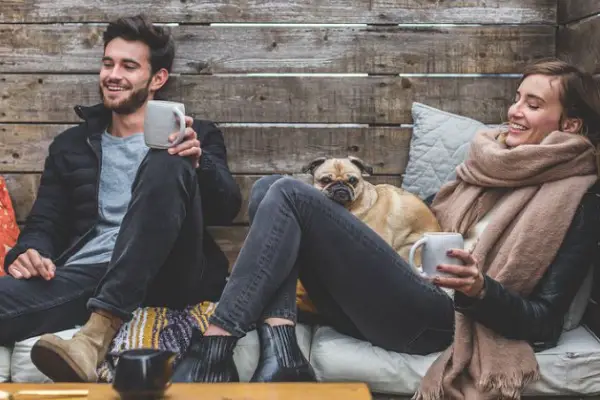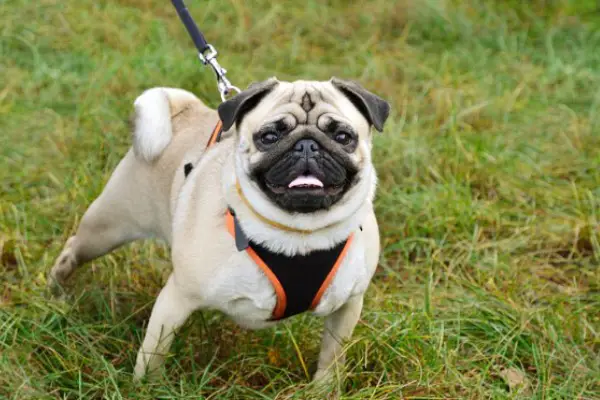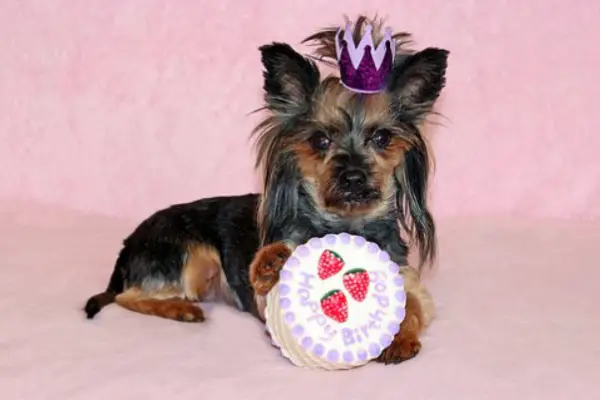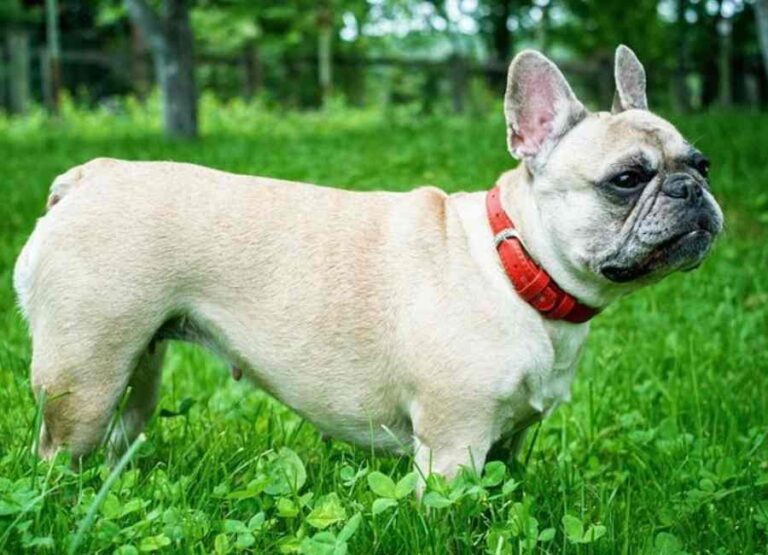Pug Pros And Cons (18 Things To Know About Pugs)

Are you looking for pug pros and cons, then you are in the right place, we will be discussing the most common pug pros and cons you should know.
Pugs are known to be a good breed for less active people because they don’t require much exercise.
So, what should you expect from owning a pug let’s look at some common pug pros and cons.
Pug Pros And Cons
The following are some of the most popular benefits and drawbacks of owning a pug that you should be aware of before owning one:
Let’s start with the pros…
1. Pugs are good for apartment dwellers
A pug is the best breed of dog for you if you need a dog that can live with you in your limited surroundings.
Pugs are little dog breeds that thrive in apartments due to their small size, low activity levels, and minimal need for exercise.
Pugs are OK wherever you live as long as you’re with them; they don’t care where you are or what you’re doing as long as you’re with them.
Pugs have the advantage of being able to live in both an apartment and a country property.
They are so devoted to the owner that if required, they would live in a tent.
2. Pugs make good watchdogs
Pugs have excellent hearing and vision, and having one around the house provides security.
If a stranger enters the house or trespasses, your pug will bark incessantly to alert you.
They’re reputed to be great watchdogs. You won’t have to worry as much about robbers and crooks breaking in unobserved with these little fellows around.
Pugs do not make ideal guard dogs, but they do make fantastic watchdogs who will always bark if a stranger enters the domain.
3. Pugs get along with other dogs
Pugs were developed to be companion dogs, and the breed has retained this selective breeding feature.
Pugs are one of, if not the best, dog breeds for getting along with other dogs because of their companion nature.
Pugs like playing, and having a second dog around makes life a lot simpler for them.
Due to their size, they may not be ideal for large dogs and are better suited to other toy dogs.
4. Pugs don’t need a lot of outdoor exercises
Because of its small size, the pug is an excellent choice for people who aren’t or can’t be active every day.
Because they’re little, they don’t require a lot of outside activities.
It may be enough to keep them healthy if you have a patio or balcony.
You can better control their requirements by taking a few excursions to the lawn to urinate or using an inside gadget.
To keep them intellectually engaged inside, you’ll want to have a range of toys accessible for them to play with, but that’s usually all you need to do.
5. Pugs get along with kids
Pugs get along well with kids provided they are taught how to handle them due to their tiny stature.
Pugs are a vivacious breed that likes playing with children but must be trained, which is why they are introduced together.
A healthy pug can play all day with a child who is eager to run around in the backyard.
When you go home, you could find your kids sleeping with your pug. This is because they have both spent their time playing video games.
Getting a pug is more frequent if you have active children, as pugs are more closely associated with children who play with them on a regular basis than those who do not.
6. Pugs make great pets for singles
Are you seeking a canine companion if you’re single? Pugs are the breed for you if this is the case.
They’ll lavish you with all the love, attention, and hugs you could ever desire.
Pugs are getting more popular as a consequence of their strong bond with their owners and families.
The pug is the breed for you if you live alone and need a dog to keep you company.
7. Pugs get along with cats
Pugs get along with cats, but they must be socialized and trained before they can stay with them.
Pug owners are enthusiastic about bringing pugs into their homes, and the majority of them agree that having pugs in the house makes living more joyful.
Before introducing a pug into a home with a cat, make sure the pug has been well-trained, especially in obedience.
8. Pugs get along with senior citizens
The pug is the dog for you if you’re a mature adult looking for a companion after you retire.
For a number of reasons, every senior citizen requires a dog, and Pug will offer you everything you need to know about living with a dog as a senior citizen.
You are, however, still responsible for brushing your pug’s long hair regularly to minimize shedding as a senior citizen.
9. Pugs are affectionate towards their owners
Few dogs, if any, can rival the loyalty of a pug; in fact, pugs regularly beg their owners for attention.
Cuddles is one of the most typical ways for a pug to display its affection for its owners; if a pug loves you, it will want to be with you all of the time.
Pugs grow anxious when they find that their owner is going to work and begin barking excessively to get your attention.
This breed is aware of your concern and wishes to assist you in feeling better.
They are loving, however, they will communicate their dissatisfaction with being held swiftly.
10. Pugs make excellent companion dogs
Pugs are mainly companion animals that help those in need by providing friendship and affection.
Even if a person is in a stressful situation, this breed may be able to provide comfort and peace.
As a result, these pups are regularly seen in nursing homes and assisted living facilities, as well as with elders and older couples.
Young folks and families with older children are also fans of this breed.
Let’s look at some cons…
11. Pugs do snore while sleeping
One of the main reasons why you shouldn’t buy a pug if you can’t handle noisy snoring is excessive snoring.
Pugs have a tough time taking in enough oxygen due to the shape of their snout and their size.
Snoring can result from an inability to take in enough breath, which can be an issue for most individuals.
People, on the other hand, tend to overlook or become accustomed to their snoring due to their pleasant personalities.
As a result, if you aren’t prepared to hear your puppy snore as you sleep, the pug isn’t for you.
13. Pugs easily get overweight
Because pugs are prone to obesity, you may readily locate photographs of overweight pugs on the internet.
The majority of the time, pugs get overweight because their owners don’t know when or how to limit their pup’s food.
If you allow them, pugs may be lethargic; their favorite activities are eating and sleeping, which is a formula for obesity.
There are a few causes for your pug’s excessive sleeping that may be addressed.
14. Pugs are prone to heat issues
This is a major disadvantage of pugs, implying that they are not suitable for persons who like vigorous exercise or who live in hot climates.
Again, the shape of their snout is a crucial factor in their susceptibility to heat exhaustion, since they are unable to take in enough oxygen.
This means you’ll keep an eye on your pug’s indoor and outdoor activities to make sure they’re not overworked.
Even though pugs get along well with children, they must be taught how to interact with them and when to stop playing in order to avoid overheating and heatstroke.
15. Pugs are known to have separation anxiety easily
Pug separation anxiety is a behavioral issue that can arise when a pug is left alone for an extended period of time.
If left untreated, it can lead to biting, excessive barking, and antagonism.
Biting, weeping, barking, self-isolation, destructive chewing, and other behaviors are all signs of separation anxiety in pugs.
When a pug is left alone at home, it might develop separation anxiety, which can be alleviated by having a companion or using good crate training.
To put it another way, unless you have someone else at home, pugs are not for you if you have a 9 to 5 work.
16. Pugs are known for clingy behavior
While some people find it irritating that their pugs follow them around the house, others find it entertaining.
Pugs are no exception when it comes to barking, biting, or nipping to get attention.
If you don’t want a loving dog who needs regular care, a pug is not for you.
Pugs are fantastic companion dogs that spend their days with their owners; yet, if they are not properly controlled, they may become a major issue.
17. Pugs do shed regularly
Pugs do shed throughout the year, but they shed the most in the spring and fall, with the greatest shedding in the spring. As a result, pugs are known as a breed that sheds excessively.
While all dogs shed to some degree, it is a normal process that preserves their skin and aids in body temperature regulation.
Pugs do shed more than most dogs due to their double coat.
Excessive pug shedding can be reduced with food, grooming, and vitamins, but it cannot be prevented.
18. Pugs have some health challenges
Because of their short snout and constricted nose, they are prone to a range of respiratory illnesses.
Dogs with this physical structure commonly experience respiratory problems.
They are also more vulnerable to a wide range of health issues.
Hip dysplasia, eye diseases, respiratory issues, and other disorders might make your pug unwell.
All of these health issues will cost you a lot of money. The health of your pug will be quite expensive.



![Dog Drinking a Lot of Water And Not Eating [Explained] Dog Drinking a Lot of Water And Not Eating](https://petcreeks.com/wp-content/uploads/2023/02/Dog-Drinking-a-Lot-of-Water-And-Not-Eating-768x555.jpg)


![10 Causes of Shih Tzu Itching and Licking [Useful Tips] Shih Tzu Itching And Licking](https://petcreeks.com/wp-content/uploads/2023/04/Shih-Tzu-Itching-And-Licking.jpg)